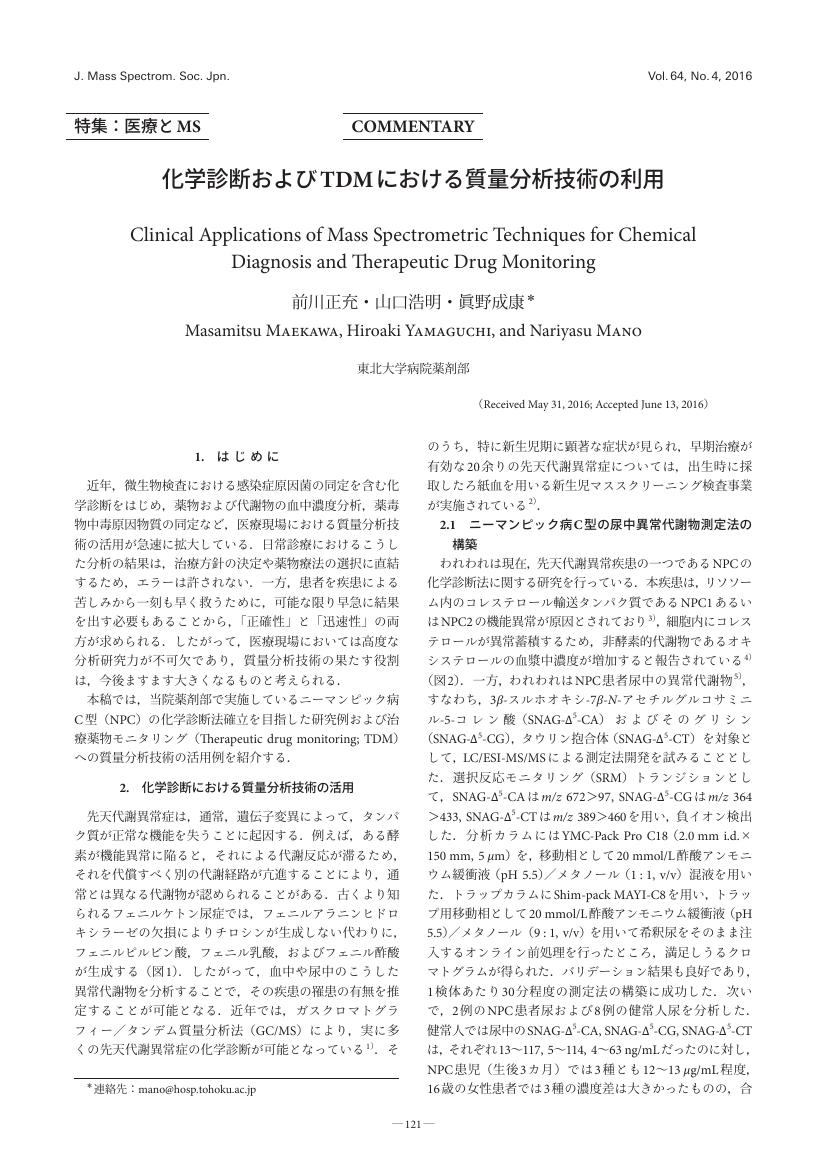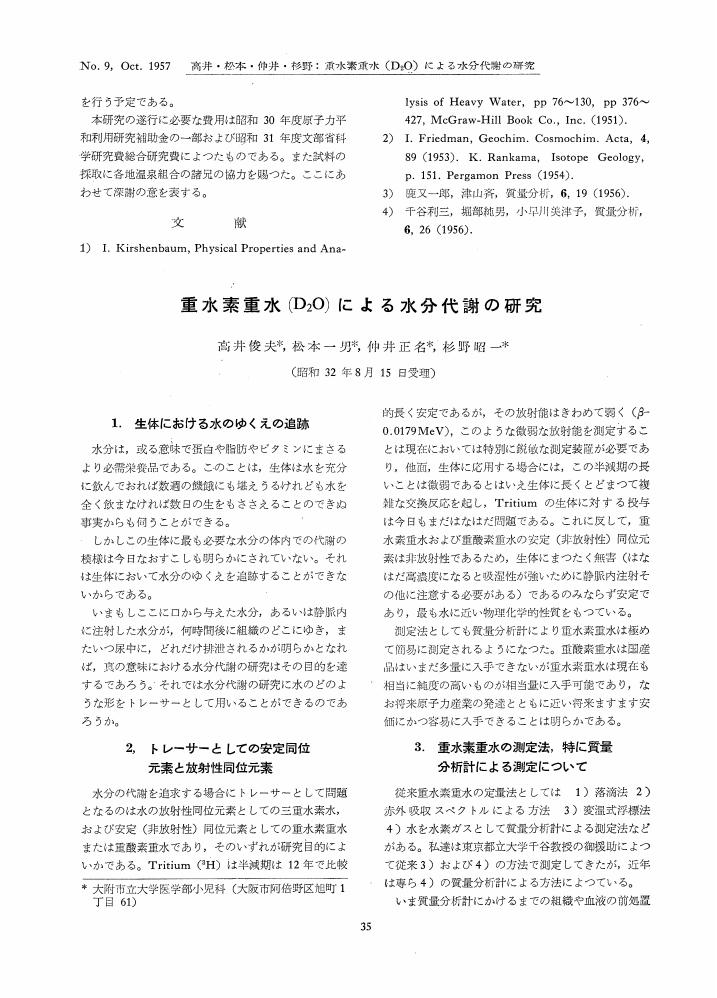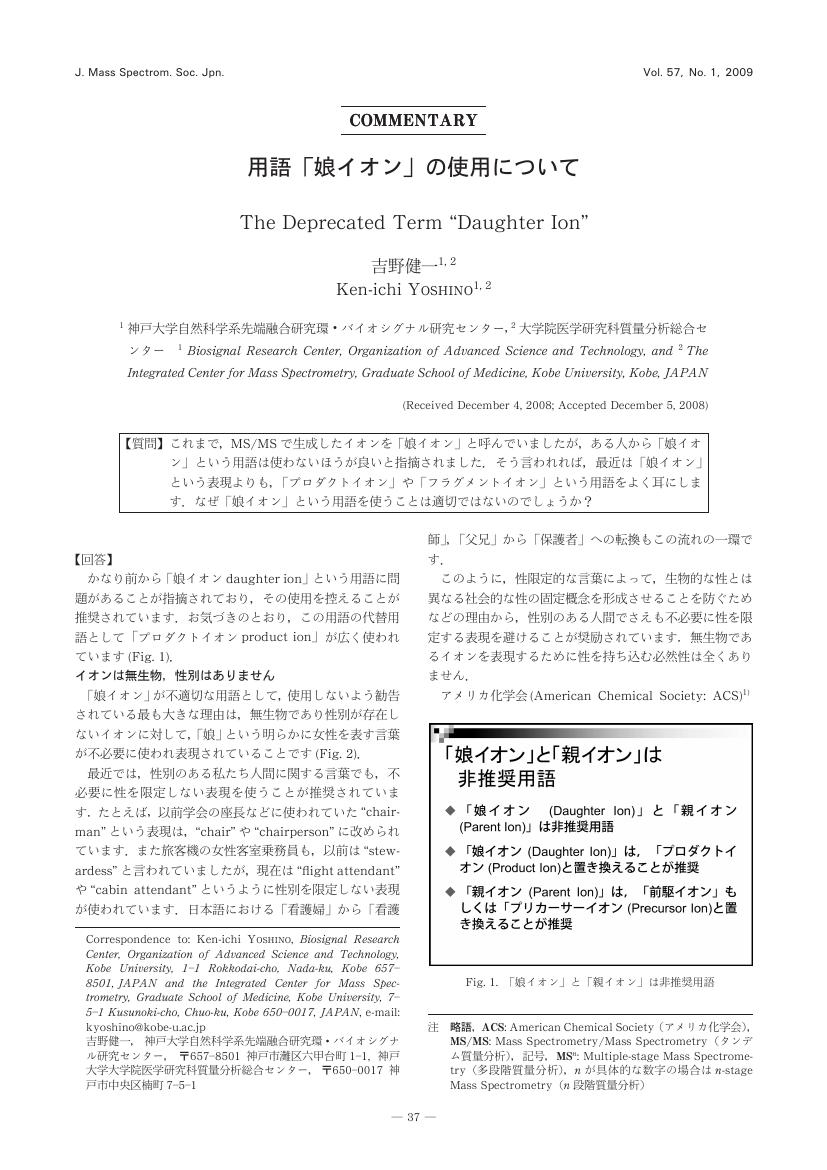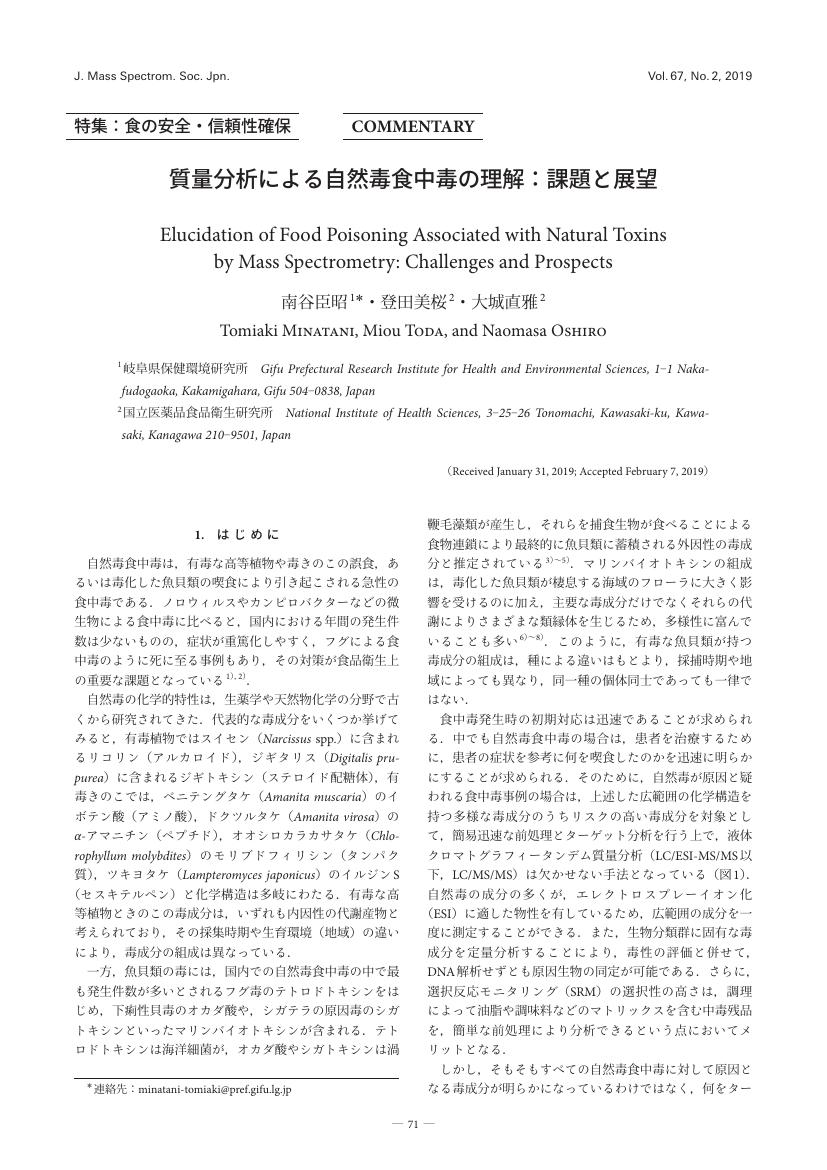- 著者
- 吉野 健一
- 出版者
- 一般社団法人 日本質量分析学会
- 雑誌
- Journal of the Mass Spectrometry Society of Japan (ISSN:13408097)
- 巻号頁・発行日
- vol.55, no.2, pp.99-115, 2007 (Released:2007-04-15)
- 参考文献数
- 27
- 被引用文献数
- 6 7
Ions are not organisms, and thus they do not proliferate by either sexual or asexual reproduction. They are hence incapable of being parents, children, or grandchildren. Therefore, the terms “parent ion,” “daughter ion,” and “granddaughter ion” are scientifically incorrect. In addition, mass spectrometrists should note that the terms “daughter ion” and “granddaughter ion” are gender-specific. (The terms “daughter nuclide” and “granddaughter nuclide” are also gender-specific.) Therefore, the terms “parent ion” and “daughter ion” need to be replaced by “precursor ion” and “product ion,” respectively. Instead of the gender-specific terms “granddaughter ion” and “great-granddaughter ion,” the gender-neutral terms “second generation product ion” and “third generation product ion” should be used.
5 0 0 0 OA 炭素12のモル質量は12 gではなくなりました
- 著者
- 浅川 大樹
- 出版者
- 一般社団法人 日本質量分析学会
- 雑誌
- Journal of the Mass Spectrometry Society of Japan (ISSN:13408097)
- 巻号頁・発行日
- vol.71, no.1, pp.34-35, 2023-03-01 (Released:2023-03-15)
- 参考文献数
- 5
4 0 0 0 OA 植物科学における一細胞質量分析法:植物ホルモンの定量と今後の展望
- 著者
- 清水 崇史 渡邊 俊介 鈴木 洋弥 竹林 裕美子 瀬尾 光範
- 出版者
- 一般社団法人 日本質量分析学会
- 雑誌
- Journal of the Mass Spectrometry Society of Japan (ISSN:13408097)
- 巻号頁・発行日
- vol.68, no.2, pp.26-32, 2020-04-01 (Released:2020-04-15)
- 参考文献数
- 15
3 0 0 0 OA m/z の定義とその使用法について
- 著者
- 内藤 康秀
- 出版者
- 日本質量分析学会
- 雑誌
- Journal of the Mass Spectrometry Society of Japan (ISSN:13408097)
- 巻号頁・発行日
- vol.54, no.5, pp.217-217, 2006 (Released:2006-10-03)
- 被引用文献数
- 3 5
3 0 0 0 OA 植物運動とそれを担うタンパク質 オジギソウの屈曲運動を中心として
- 著者
- 神沢 信行 土屋 隆英
- 出版者
- 一般社団法人 日本質量分析学会
- 雑誌
- Journal of the Mass Spectrometry Society of Japan (ISSN:13408097)
- 巻号頁・発行日
- vol.51, no.1, pp.85-90, 2003 (Released:2007-10-16)
- 参考文献数
- 12
- 被引用文献数
- 2 2
The sensitive plant, Mimosa pudica L. closes the leaves and hangs the petiole down when stimulated by touch or heat treatment. This bending of the petiole is caused by rapid shrinking of the lower side of motor organs called the pulvinus. MRI technique indicates that the water in the main pulvinus transfers from the flexor to the extensor during the rapid bending. The actin cytoskeleton in the motor cells plays in important role in the petiole bending. The actin molecules in Mimosa pudica L. is heavily tyrosine-phosphorylated. The bending of Mimosa pudica L. is correlated with reduced actin phosphorylation in the pulvinus.
- 著者
- 山垣 亮 木村 優佳 山崎 堯嗣
- 出版者
- 一般社団法人 日本質量分析学会
- 雑誌
- Journal of the Mass Spectrometry Society of Japan (ISSN:13408097)
- 巻号頁・発行日
- vol.69, no.2, pp.23-29, 2021-04-01 (Released:2021-04-15)
- 参考文献数
- 8
- 被引用文献数
- 1
We optimized the suppression method of peptide adsorption of neuropeptide Y (NPY) in the experimental tubes for the sensitive quantitative LC-MS analysis. A large peptide of Orexin-B and small tryptic digested bovine albumin (BSA) peptides suppressed effectively the adsorption of NPY in 35–50% acetonitrile with 0.1% trifluoroacetic acid aqueous solution. Orexin-B adsorbed on the experimental tubes competitively to NPY, and the tryptic digested BSA peptides suppressed the aggregation of NPY inducing the adsorption or the deposition of NPY on the tube in the solution.
- 著者
- 吉野 健一
- 出版者
- 一般社団法人 日本質量分析学会
- 雑誌
- Journal of the Mass Spectrometry Society of Japan (ISSN:13408097)
- 巻号頁・発行日
- vol.56, no.1, pp.27-32, 2008-02-01 (Released:2008-02-26)
- 参考文献数
- 2
- 被引用文献数
- 1 1
The terms “accurate mass” and “exact mass” are not synonymous in mass spectrometry. Accurate mass refers to the mass value of an ion or radical determined experimentally by mass spectrometry. On the other hand, exact mass refers to the mass value of a single ion, radical, or molecule calculated by summing the mass values of individual isotopes. To avoid confusion, “measured accurate mass” and “calculated exact mass” should be used in place of “accurate mass” and “exact mass,” respectively.
3 0 0 0 OA ナノ液体クロマトグラフィー質量分析を基盤としたシングルセル分子フェノタイプ解析
- 著者
- 和泉 自泰 中谷 航太 秦 康祐 原 健士 松本 雅記 馬場 健史
- 出版者
- 一般社団法人 日本質量分析学会
- 雑誌
- Journal of the Mass Spectrometry Society of Japan (ISSN:13408097)
- 巻号頁・発行日
- vol.68, no.2, pp.44-48, 2020-04-01 (Released:2020-04-15)
- 参考文献数
- 26
- 被引用文献数
- 1
3 0 0 0 OA メタボロミクスにおける脂溶性代謝物解析
- 著者
- 池田 和貴 馬場 健史
- 出版者
- 日本質量分析学会
- 雑誌
- Journal of the Mass Spectrometry Society of Japan (ISSN:13408097)
- 巻号頁・発行日
- vol.65, no.5, pp.199-202, 2017-10-01 (Released:2017-10-15)
- 参考文献数
- 6
3 0 0 0 OA 化学診断およびTDMにおける質量分析技術の利用
- 著者
- 前川 正充 山口 浩明 眞野 成康
- 出版者
- 日本質量分析学会
- 雑誌
- Journal of the Mass Spectrometry Society of Japan (ISSN:13408097)
- 巻号頁・発行日
- vol.64, no.4, pp.121-125, 2016-08-01 (Released:2016-08-15)
- 参考文献数
- 13
- 被引用文献数
- 1
2 0 0 0 OA セルロースの熱分解と焦げ臭
- 著者
- 前川 麻弥 能美 隆
- 出版者
- 一般社団法人 日本質量分析学会
- 雑誌
- Journal of the Mass Spectrometry Society of Japan (ISSN:13408097)
- 巻号頁・発行日
- vol.46, no.4, pp.308-316, 1998 (Released:2007-07-20)
- 被引用文献数
- 4 4
Pyrolysis mechanism of cellulose and it's roasted odor were studied by odor sensor, GC-MS and TG-MS. The roasted odor was generated from 170°C when cellulose was heated and decomposed. Odor sensor made of tin oxide semiconductor thin film detected the odor products at 170°C. A human nose could detect the odor at the same temperature. The human and the artificial nose could be understood to sense the same evolved gas among the decomposition products. We analyzed the decomposition products of cellulose and found levoglucosan as a main product around 300-400°C by GC-MS under He condition. TG-MS study was carried out under air condition and levoglucosan was detected. Levoglucosan (mp 182°C, bp 280°C) was estimated to sublimate over the temperature of 200°C. When the cellulose pyrolized, the chemical weak bonding of -O- was scissored randomly. Finally this scission stopped when it created the monomer unit of cellulose, i.e., levoglucosan. Considering these facts we concluded the roasted odor by the decomposition of cellulose must be levoglucosan.
2 0 0 0 OA 重水素重水(D2O)による水分代謝の研究
- 著者
- 高井 俊夫 松本 一男 仲井 正名 杉野 昭一
- 出版者
- 一般社団法人 日本質量分析学会
- 雑誌
- Journal of the Mass Spectrometry Society of Japan (ISSN:13408097)
- 巻号頁・発行日
- vol.1957, no.9, pp.35-43, 1957-10-01 (Released:2010-06-28)
2 0 0 0 OA なぜリフレクトロンモードやマルチターンによって質量分解能が向上されるのか
- 著者
- 田中 耕一 吉野 健一 内藤 康秀 豊田 岐聡
- 出版者
- 一般社団法人 日本質量分析学会
- 雑誌
- Journal of the Mass Spectrometry Society of Japan (ISSN:13408097)
- 巻号頁・発行日
- vol.56, no.2, pp.49-54, 2008-04-01 (Released:2008-04-15)
- 被引用文献数
- 2 2
Linear mode, reflectron mode, and multi-turn are techniques for m/z analysis in time-of-flight mass spectrometry. Reflectron mode and multi-turn enable analysis to be performed with a higher mass resolving power than that attained with linear mode. In this commentary, starting from the basic principles of time-of-flight mass spectrometry in linear mode, the possible improvements in mass resolving power that can be made by reflectron mode and multi-turn techniques will be explained.
2 0 0 0 OA 火山ガスと防災
- 著者
- 平林 順一
- 出版者
- 一般社団法人 日本質量分析学会
- 雑誌
- Journal of the Mass Spectrometry Society of Japan (ISSN:13408097)
- 巻号頁・発行日
- vol.51, no.1, pp.119-124, 2003 (Released:2007-10-16)
- 参考文献数
- 5
- 被引用文献数
- 5 6
A large amount of SO2 gas was discharged from Miyakejima volcano since the end of September, 2000. The averaged SO2 flux was about 50,000 ton/day in 2000. About 4,000 people could not returned to the island, because SO2 gas has been discharged, and more than 5 ppm of SO2 gas concentrations has been observed frequently around the island. In generally, volcanic gas contains mainly water vapor. The dry gas is largely composed of HF, HCl, SO2 , H2S and CO2 with small amount of N2, H2, He, Ar, CH4 and CO. HF, HCl, SO2 and H2S gases have high toxicity. The volcanic gas disaster occupied about 2.5% of volcanic disaster based on the dead since 1900. In Japan, disasters by volcanic gas occurred 28 times around eleven active volcanoes and 49 people were died during the recent 50 years. Occurrence of volcanic gas disaster is mainly dominated by the configuration of ground around fumarolic area and meterological conditions such as windless, cloudy, foggy weather and formation of inversion layer. SO2 has been released at Oyama volcano in Miyakejima island for more than two years, and the inhabitants had to leave the island. Volcanic gas disaster is influenced by meteorological conditions and local geology. In case of big eruption, volcanic gas ascends to the stratospheric, and aerosol causes low temperature in the world. To reduce the disaster of volcanic gas, it is needed to monitor with a selective gas sensor and to alarm people the forecasted dangers.
2 0 0 0 OA 用語「娘イオン」の使用について
- 著者
- 吉野 健一
- 出版者
- 一般社団法人 日本質量分析学会
- 雑誌
- Journal of the Mass Spectrometry Society of Japan (ISSN:13408097)
- 巻号頁・発行日
- vol.57, no.1, pp.37-39, 2009-02-01 (Released:2009-02-16)
- 参考文献数
- 4
- 被引用文献数
- 1 1 1
2 0 0 0 OA 呼気中バイオマーカーとしての揮発性有機化合物の質量分析
- 著者
- 澤野 誠
- 出版者
- 一般社団法人 日本質量分析学会
- 雑誌
- Journal of the Mass Spectrometry Society of Japan (ISSN:13408097)
- 巻号頁・発行日
- vol.66, no.3, pp.135-138, 2018-06-01 (Released:2018-06-15)
- 参考文献数
- 11
- 著者
- 吉野 健一
- 出版者
- 一般社団法人 日本質量分析学会
- 雑誌
- Journal of the Mass Spectrometry Society of Japan (ISSN:13408097)
- 巻号頁・発行日
- vol.55, no.6, pp.381-388, 2007 (Released:2007-12-15)
- 参考文献数
- 9
- 被引用文献数
- 1 1
In terms related to mass spectrometry, “TIC” should be used as an abbreviation for “total ion current.” However, many mass spectrometrists use “TIC” as an abbreviation for “total ion chromatogram” while referring to “total ion current chromatogram,” which is incorrect. Another common misunderstanding related to abbreviations is the usage of “MCP” as an abbreviation for “multichannel plate,” which should be used for “microchannel plate.”
2 0 0 0 OA 質量分析による自然毒食中毒の理解:課題と展望
- 著者
- 南谷 臣昭 登田 美桜 大城 直雅
- 出版者
- 一般社団法人 日本質量分析学会
- 雑誌
- Journal of the Mass Spectrometry Society of Japan (ISSN:13408097)
- 巻号頁・発行日
- vol.67, no.2, pp.71-77, 2019-04-01 (Released:2019-04-15)
- 参考文献数
- 30
2 0 0 0 OA 一細胞質量分析を用いた循環腫瘍細胞解析の試み
- 著者
- 檜山 英三 原田 隆範 兒島 正人
- 出版者
- 一般社団法人 日本質量分析学会
- 雑誌
- Journal of the Mass Spectrometry Society of Japan (ISSN:13408097)
- 巻号頁・発行日
- vol.68, no.2, pp.33-37, 2020-04-01 (Released:2020-04-15)
- 参考文献数
- 2
Circulating tumor cell (CTC) has improved the study of cancer disease as it represents a noninvasive biopsy that can be used as prognostic and prediction biomarkers as well as for future molecular diagnosis as an accurate selection of molecular targets and effective drugs. As tumor heterogeneity exists in neuroblastoma (NBL), we aimed to evaluate lipid-metabolomic molecular profile as well as genetic profiles at the single cell level of CTC for better understanding the heterogeneity and malignant grade of NBL. For attempt of CTC analysis in NBL patients, we have isolated single-CTCs and then performed direct trapping of a single cell within a nanospray tip followed by super-sonication after the addition of ionization solvent for metabolomics analysis. And we also performed genomic aberrations and expressions using next-generation sequencing after whole genome/transcriptome amplifications (WGA/WTA). In the NBL-CTCs, metabolomic analysis detected catechol amine metabolites, which are specific to NBL, and drugs included in the patient’s course of therapy in addition to vital molecules such as amino acids. In genomic analysis, the average amount of amplified DNA was 19.0 µg, and the percentage of reads mapped to any targeted region relative to all reads mapped to the reference was 66.5–98.9%. The concordance rates of CTC and tumor mutations were 49–80%. The genomic expression analysis in CTC showed the activation of cancer metastatic, neurogenic, stem cell signaling pathway genes. This “direct single-cell analysis method” seems to be useful for direct and wide range genomic and molecular marker detection in NBL-CTC, for evaluating heterogeneity of NBL tumor at diagnosis as well as during treatments. This method will be applicable for selection of effective drugs and evaluation of treatment efficacy in future.
2 0 0 0 OA LC/MSのためのエレクトロスプレーイオン化法 基礎
- 著者
- 山垣 亮
- 出版者
- 一般社団法人 日本質量分析学会
- 雑誌
- Journal of the Mass Spectrometry Society of Japan (ISSN:13408097)
- 巻号頁・発行日
- vol.65, no.1, pp.11-16, 2017-02-01 (Released:2017-02-15)
- 参考文献数
- 41
- 被引用文献数
- 1







